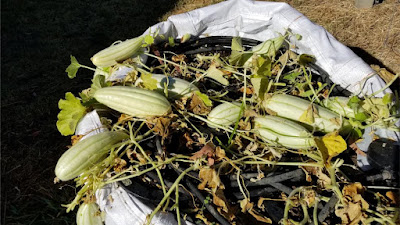Friday, January 5, 2024
The Palestinian Faqous or Fakkous
Friday, December 29, 2023
Greenhouse Ogurdynya Tohum Russian Cucumbermelon in the Spring
Eventually the seed
packets arrived, and I grew it once in 2022. And it was a good thing
that I did. The initial seed that I received hardly germinated in the
spring of 2023. So I sowed my seed fresh seed early in 2023 and watched
the plants grow.
Just as I had noticed
previously, the vines were somewhat spiky – much like a Cucumis sativus.
However, unlike the C. sativus, the flowers were much more like a
Cucumis melo in that the flowers were much more fuzzy than spiky. While I
am not specifically sure what variety it is, I believe that it is
either an Asian pickling melon (C. melo var conomon) or a snapmelon (C.
melo var momordica).
This “Russian
cucumbermelon” is somewhat fun to grow in that the vines are very weedy and tend to sprawl from the center.
Each plant has thin-stemmed vines that frequently branch off from the
primary stem with their own side stems.
The light fruit with
mottled bands has a somewhat hard crunchy outer layer and a more tender
slightly sweet inner flesh when young. As they mature they possess a
sweet crisp outer layer with a softer sweet juicy center. The mature
fruit eventually end up splitting open as they mature – much more like a
snapmelon than an Asian pickling melon.
All-in-all I really enjoyed growing the Ogurdynya Tohum Russian Cucumbermelon. They are simple, easy and somewhat tasty. As a whole, they are a lot of fun to grow in a small space, such as a greenhouse.
Friday, December 22, 2023
Growing the Goldini 2 Zucchini
Since reading the The Resilient Gardener, I have been looking forward to growing more of Carol Deppe’s vegetable varieties. One of the more recent varieties, called Goldini zucchini, was released in 2016. I had heard of it previously, but had never had a chance to grow it until this last year. However, it was not Goldini I purchased, but an improved line of Goldini, called Goldini 2, which was just recently released.
The most important thing for me about zucchini is texture and flavor. Remaining tender until very large is highly important, as is having a pleasing flavor too. Those of us who home garden are not as concerned about ability to ship the product as we are in having strong healthy plants that produce tender delicious fruit.
Goldini was a result of crossing an F2 Gold Rush Hybrid with Costata Romanesco, with the Romanesco as the pollen receiver and female parent for Goldini. Goldini has the flavor reminissent of a Costata Romanesco with the easy-to-find yellow color of the Gold Rush.
Another aspect of this variety that makes it
really worth growing is its adaptability to be consumed raw, cooked, or dried to later provide an ingredient in soups and stews.
My experience with the Goldini 2 was very
positive. In relation to other open-pollinated varieties, it was highly
productive and very good. I would definitely recommend this variety to anyone
else who would like to produce a heavy crop of delicious yellow summer squash.



























































































